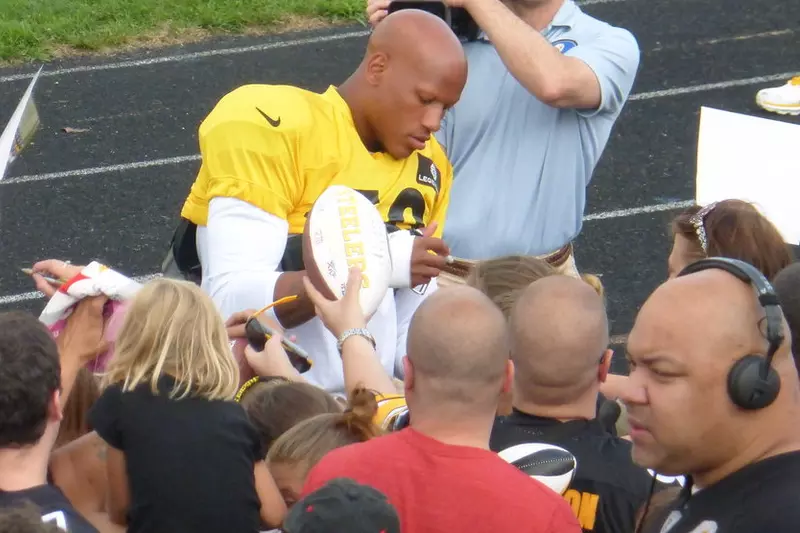- AdventHealth

It was supposed to be a routine tackle. Instead, the collision on Dec. 4, 2017 ended up changing Pittsburgh Steelers linebacker Ryan Shazier’s life.
After the helmet-first hit, he was diagnosed with a spinal cord injury and underwent surgery to stabilize his spine. Though unable to walk at first, Shazier was brimming with determination: He would return to the football field.
Since then, he’s been undergoing extensive physical rehabilitation. In early April, Shazier shared a video with ESPN of him doing box jumps with the help of a physical therapist.
He hasn’t made it back yet — the Steelers recently placed him on a list of people unable to play this year — but his progress has been nonetheless remarkable. Shazier’s perseverance and capacity to inspire belief has earned him the hashtag #Shalieve.
Laura Patrick, clinical and operations manager with AdventHealth Sports Med and Rehab, said Shazier had what’s called an “incomplete” spinal cord injury. This means the spinal cord was not completely severed, so he retained at least some sensation and strength below where the injury occurred.
“It’s difficult to predict what long-term outcomes will be after an incomplete spinal injury,” Patrick says, “but physical therapy can help you recover more of your previous functionality.”
Working with athletes can be more challenging because they generally want to return to the pinnacle of performance instead of simply performing day-to-day activities without pain.
“An athlete tends to have strong motivation and is used to exercising, and they’re really fun to work with,” Patrick says.
The notion of guiding patients through goal-setting to see what they want from treatment is a bedrock principle of physical therapy.
“We want to make sure we’re focusing on what’s most important to them,” she says. At the same time, a physical therapist draws on their patients’ other sources of strength, such as friends, family and faith.
Faith as Medicine: ‘God Is Great’
Many patients find purpose in their faith.
“One reason I love working at AdventHealth is we don’t have to shy away from faith, and I sometimes pray with patients,” Patrick says. “Our whole-person care screenings also offer spiritual care.”
Faith appears to be part of Shazier’s life, too. “God is Great,” he recently Tweeted.
Recovery Is One Day at a Time
One of the first steps in recovery from a spinal cord injury like Shazier’s is to prevent muscles from wasting away, or atrophying, due to their underuse.
If a person with a spinal cord injury is having trouble moving their muscles, the physical therapist can use what’s called an electrical stimulation, or e-stim, machine. This process, which isn’t painful, can help our body relearn how to contract muscles even without a signal from the brain.
As recovery progresses, a person will move from flexing individual muscles to moving several at once. Along the way, the physical therapist will help their patient take small steps, Patrick explains.
One tool to help is called a body weight supported treadmill. The patient is outfitted in a harness and practices walking on the treadmill. It’s a little like how a child uses training wheels to learn how to ride a bike.
Repetitive exercise can help people with spinal cord injuries for another fascinating reason. Though we normally think of nerve signals as originating in the brain, it turns out that our spine can also drive movement separately from the brain.
In recent years, physical therapists have used repetitive training principles to allow for a return to walking. These rhythmic activities can kickstart the spine’s ability to generate the reciprocal movement patterns needed for recovery.
But it’s important to take this process slowly, Patrick says. Starting to run before your ankles and knees are ready can create new problems.
In the recent video of Shazier performing box jumps, an athletic trainer or physical therapist has his hands on Shazier’s hips. Providing core stability in this way is another method physical therapists use to help their clients succeed, Patrick explains.
Encouraging patients to exercise at home is also a big part of recovery.
“We always give our patients a home exercise program,” Patrick says. Meanwhile, higher-level balance and skill-building activities are usually performed under the physical therapist’s guidance.
It’s a bit like school in that the learning takes place with the teacher but much of the practice happens at home.
It’s important to celebrate even small achievements that build toward recovery, she says. You have to be willing to walk before you learn to run, metaphorically and literally.
“Let’s set realistic goals that help you meet your big goals over time,” she says.
Again, what recovery looks like depends on a patient’s goals. If a person wants to, say, be able to go hiking again, recovery might start with walking along the parallel bars before moving to walking without assistance.
Eventually, she’ll work toward walking on uneven surfaces and up and down hills, but each step may come slowly.
Not Only Injuries
As manager of AdventHealth Sports Med and Rehab’s neurological rehabilitation program, Patrick sees a wide variety of patients. That includes people with injuries as well as those with progressive diseases. Here are some other conditions that can benefit from neurological treatment from a physical therapist:
- ALS (amyotrophic lateral sclerosis, also known as Lou Gehrig's disease)
- Amputation
- Brain injury
- Multiple sclerosis (a disease in which the immune system damages the protective covering around nerves)
- Parkinson's disease (a brain disease that affects movement)
- Postoperative brain tumor resection (after surgery to remove a tumor)
- Postoperative craniotomy (after brain surgery)
- Spinal cord injury
- Stroke
Some of these conditions, such as Parkinson’s disease and multiple sclerosis, tend to get worse over time.
“But even in these cases we can still make improvements in quality of life and help patients stay mobile in other ways,” Patrick says.
Nurturing Hope
It’s important to encourage patients to have realistic expectations for recovery while preserving their optimism and hope.
“We never want to take away someone’s hope, but we want to provide you with evidence and up-to-date information,” she says.
Whether you’re an athlete or not, AdventHealth physical therapists can help you get as much out of life as you can. Whether that means staying independent at home or performing on the field, how we move is so often connected to how we feel. Visiting a physical therapist is doing a favor for your mind and spirit as much as your body.
AdventHealth Sports Med and Rehab has 19 locations around Central Florida, meaning there’s an option close to home wherever you live. For more information, call Call407-303-8080 or visit our website.



